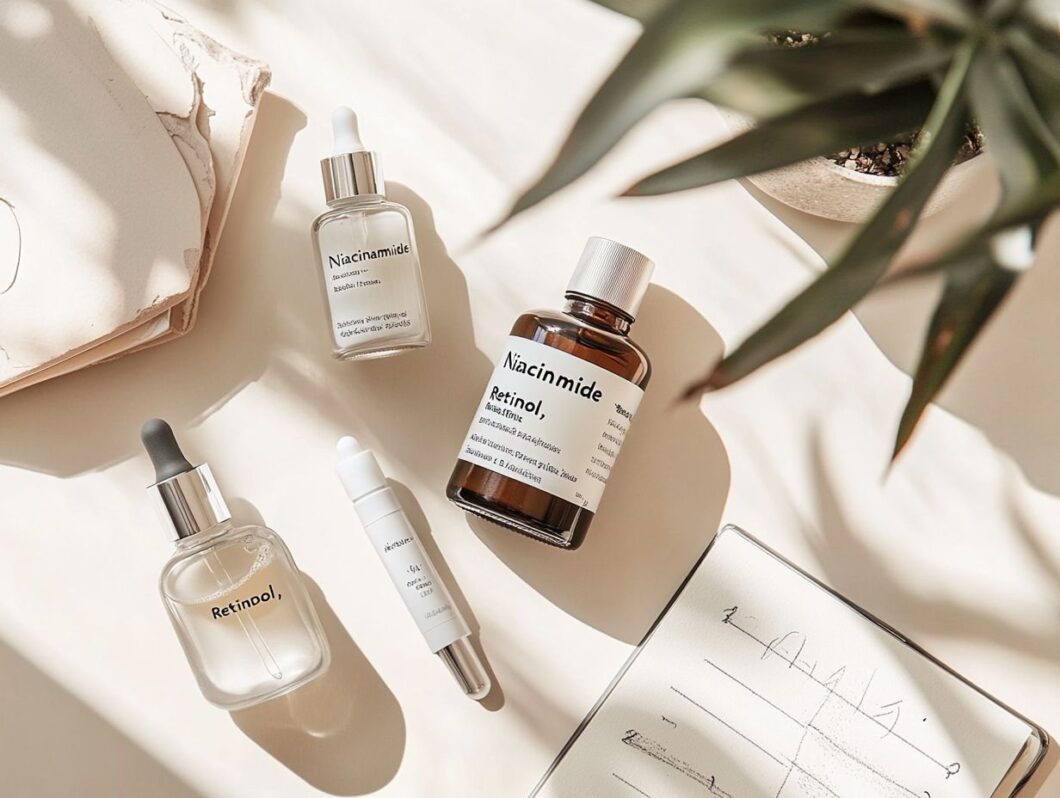Navigating the world of skincare can indeed be overwhelming, particularly with potent ingredients like niacinamide and retinol at our disposal. Both are renowned for their transformative benefits, but understanding how to use them effectively is crucial for achieving optimal results. In this article, I will delve into what niacinamide and retinol are, highlight their individual benefits, and discuss the best practices for layering them. I will also provide tips to maximize their effects and explore alternatives for those interested in other skincare options. Prepare to elevate your skincare routine.
Key Takeaways:
Understanding Niacinamide and Retinol
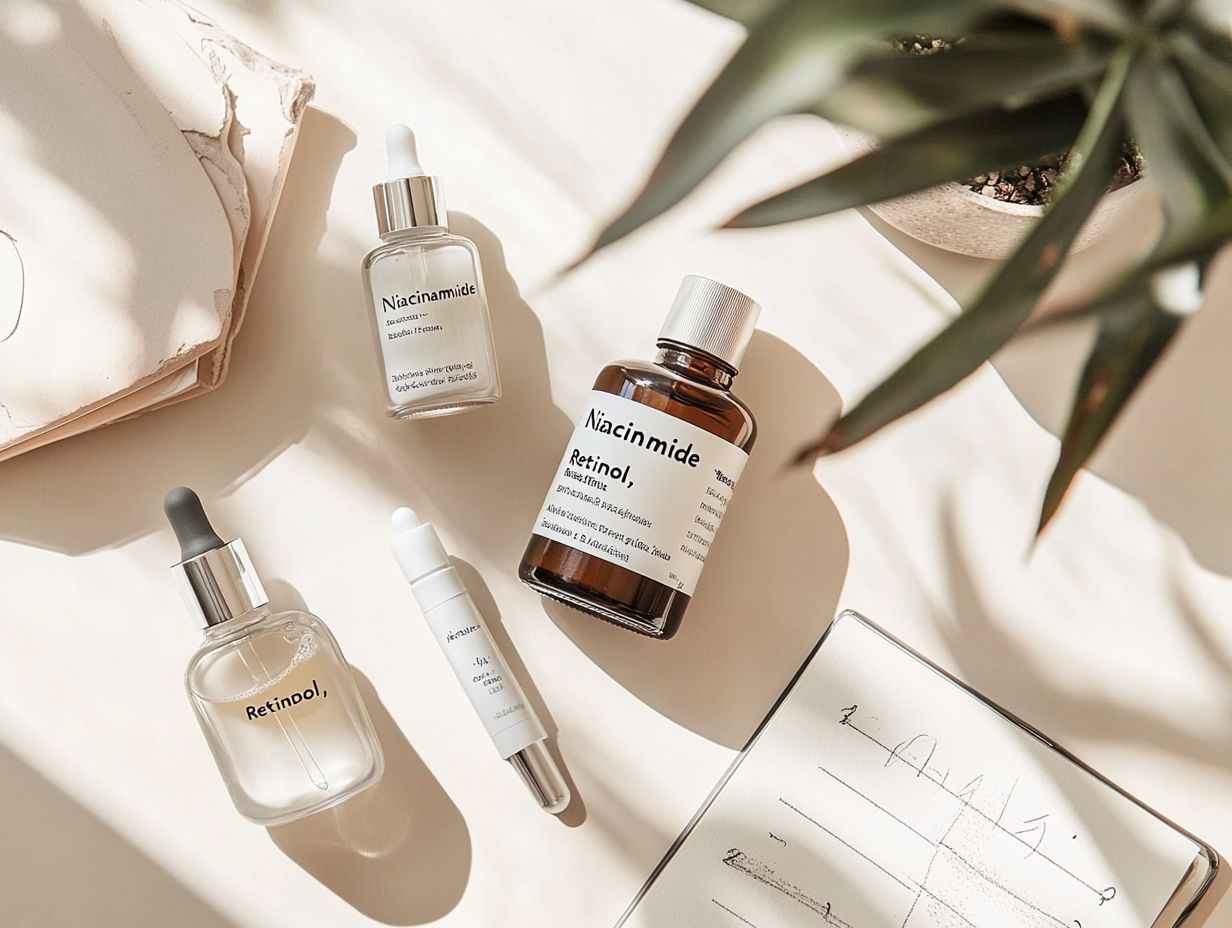
Understanding niacinamide and retinol is essential in the field of skincare, as these two potent ingredients, along with hyaluronic acid and vitamin C, play distinct yet complementary roles in enhancing skin health. Niacinamide, a form of vitamin B3, is well-recognized for its ability to improve skin barrier function, even out skin tone, and reduce inflammation. Conversely, retinol, a derivative of vitamin A, is esteemed for its anti-aging properties and its effectiveness in promoting cellular turnover, stimulating collagen production, and addressing various skin concerns such as acne and fine lines.
When used together, they create a powerful synergy in any skincare routine, maximizing their individual benefits and promoting overall skin vitality. For those interested in a comprehensive overview, this analysis by Healthline covers the intricacies of combining niacinamide and retinol.
What are Niacinamide and Retinol?
Niacinamide, commonly known as vitamin B3, and retinol, a derivative of vitamin A, are among the most sought-after ingredients in the skincare industry today. These powerful compounds are recognized for their unique chemical properties and their ability to significantly enhance skin health.
As a water-soluble vitamin, niacinamide improves the skin’s barrier function, regulates oil production, and minimizes the appearance of pores while offering antioxidant protection. In contrast, retinol is a lipid-soluble compound that promotes cell turnover by encouraging the shedding of old skin cells and stimulating collagen production, resulting in smoother, more youthful-looking skin.
Given their impressive benefits, both niacinamide and retinol have become essential components in a wide range of popular skincare products. Incorporating them into a daily routine can lead to a remarkable transformation and rejuvenation of the complexion.
Benefits of Niacinamide and Retinol
I recognize that the benefits of niacinamide and retinol are extensive, making them essential components of an effective skincare regimen that addresses a variety of skin concerns.
Niacinamide is well-regarded for its ability to improve skin barrier function, increase hydration, and reduce redness and irritation, making it suitable for all skin types. In contrast, retinol is particularly effective in promoting cell turnover, reducing fine lines, and enhancing skin texture, which helps address aging and blemish-related issues.
When used together, these ingredients not only enhance hydration and overall complexion but also support the skin’s natural restorative processes.
Key Skincare Benefits and Ingredient Compatibility
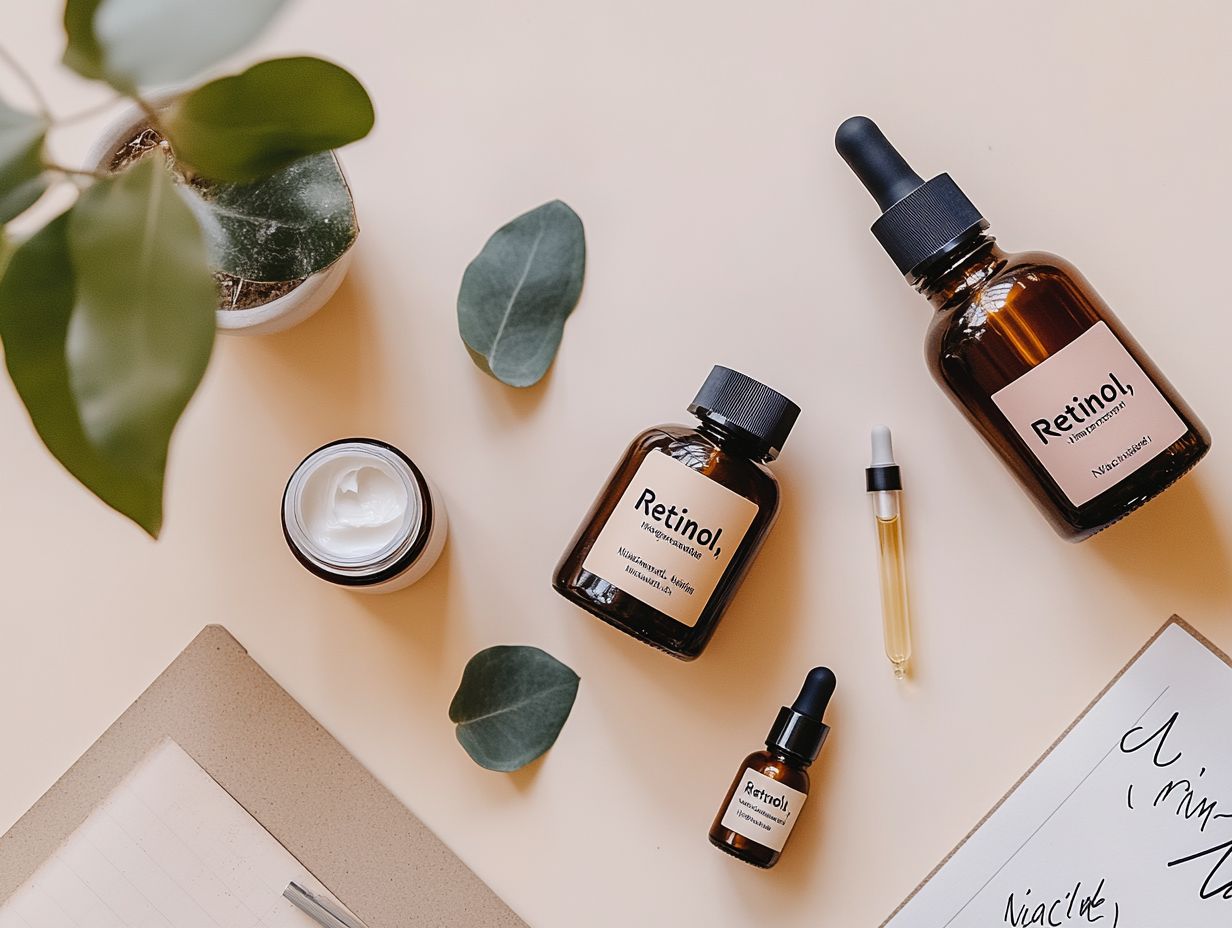
The key skincare benefits of niacinamide include its ability to enhance hydration, improve skin barrier function, and reduce signs of skin sensitivity. In my experience, retinol is particularly praised for its effective anti-aging properties and its capability to refine skin texture.
Beyond these impressive effects, I find that niacinamide is essential for diminishing the appearance of enlarged pores and uneven skin tone, making it an excellent option for individuals dealing with acne-prone or mature skin.
Its ability to regulate oil production can help prevent breakouts while also calming inflammation and redness.
On the other hand, retinol not only boosts collagen production, which reduces fine lines and wrinkles, but it also assists in exfoliating dead skin cells to reveal a brighter complexion.
Together, these ingredients often take center stage in high-quality skincare products, forming a powerful duo that can transform any skincare routine into a highly effective strategy for achieving healthier, more radiant skin.
Can Niacinamide and Retinol be Used Together in an Evening Routine?
The question of whether niacinamide and retinol can be used together in a skincare routine is a frequent topic of discussion among beauty editors and skincare enthusiasts. Both ingredients offer powerful yet distinct benefits for skin health and rejuvenation.
While there may be concerns about potential skin irritation, a wealth of studies and expert recommendations, as indicated by a discussion on Reddit, suggest that these two ingredients can effectively complement each other when applied correctly. The soothing properties of niacinamide can help alleviate some of the irritation that retinol may cause, ultimately enhancing the overall efficacy of a layered skincare regimen.
Potential Conflicts, Combinations, and Clinical Instructor Insights
When evaluating the potential conflicts and interactions between niacinamide and retinol, it is crucial to understand how these two potent skincare ingredients work together, as well as how they may affect various skin types.
While both ingredients offer a range of benefits, I recognize that using them in tandem can sometimes lead to skin irritation or sensitivity, particularly for individuals with more delicate skin. This issue arises because niacinamide functions best at a higher pH level, whereas retinol is more effective in a lower pH environment.
To minimize any adverse reactions, I recommend applying these products at different times of the day-utilizing retinol in the evening to harness its powerful effects while reserving niacinamide for the morning routine. Allowing sufficient time between applications can further assist the skin in adjusting, ensuring that each product can work effectively without compromising its stability or causing discomfort.
How to Layer Niacinamide and Retinol with Gentle Cleansers
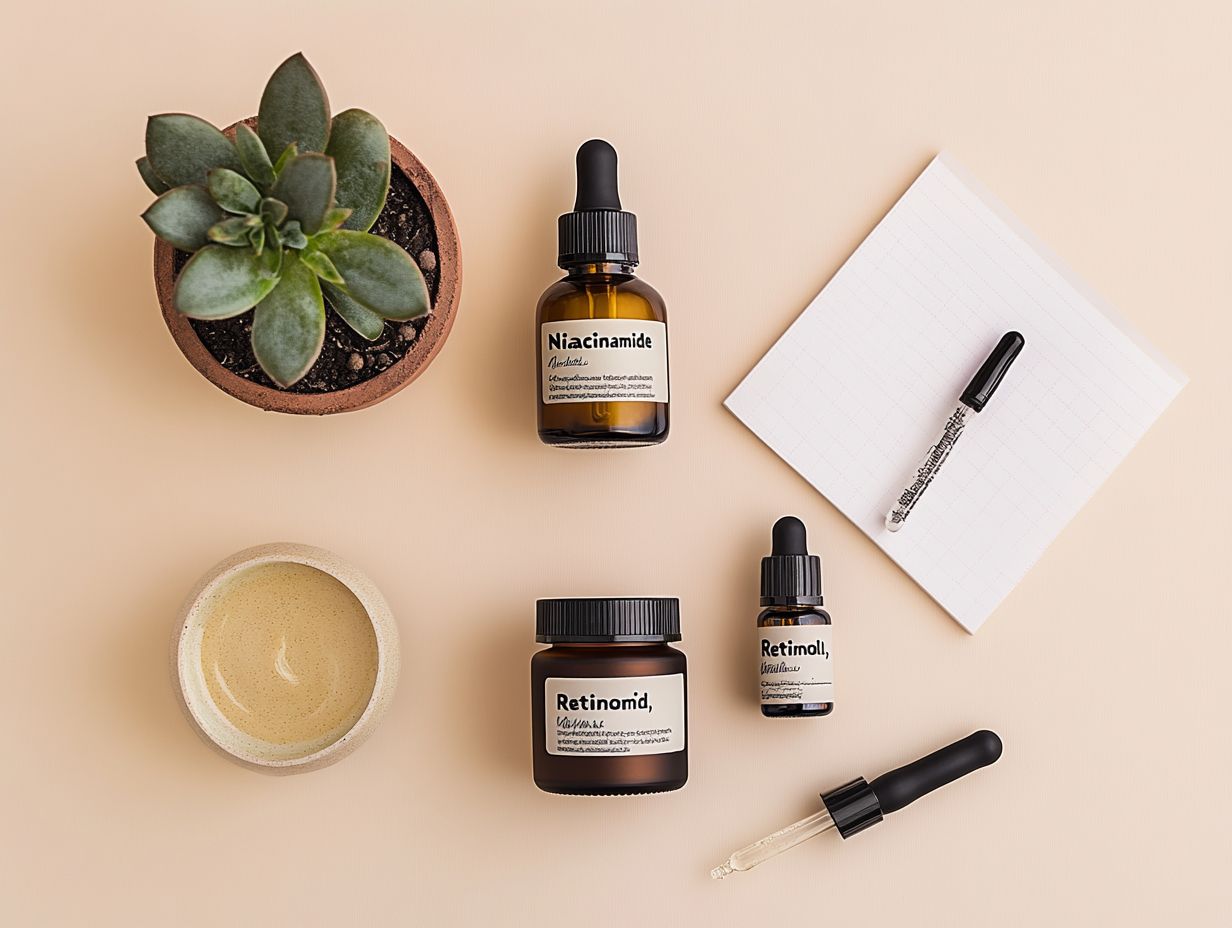
Understanding how to layer niacinamide and retinol effectively is essential for anyone aiming to maximize the benefits of these two powerful skincare ingredients, ensuring optimal absorption, improved complexion, and overall skin health.
I start the layering process with a clean canvas, using a gentle cleanser to prepare my skin. After that, I apply a niacinamide serum, which provides hydration and helps strengthen my skin barrier.
Once the niacinamide has fully absorbed, I introduce retinol into my routine, preferably in the form of a serum or cream intended for nighttime use. This approach promotes cellular turnover and addresses my skin concerns while I sleep. For those looking to master the art of layering skincare, a comprehensive guide by Allure on how to layer your skin-care products can offer additional insights and advice.
Step-by-Step Guide for Serum Layering
The step-by-step guide to layering niacinamide and retinol in my skincare regimen begins with preparing my skin using gentle cleansers. This helps remove impurities without causing irritation, which is essential for the next steps.
This crucial first step ensures that the active ingredients can penetrate effectively, enhancing their overall efficacy. After cleansing, I take care to pat my skin dry with a soft towel before moving on to the next stage.
The order of application is vital for achieving the desired results. Typically, I apply niacinamide first, as it prepares my skin for retinol, providing hydration and minimizing the potential for irritation. I always look for formulations that are compatible and known for their skin-friendly properties.
Once niacinamide has been absorbed, I apply a pea-sized amount of retinol, focusing on specific areas of concern. To further optimize my skincare routine, I incorporate a good moisturizer at the end to seal in moisture and protect my skin barrier.
Additionally, I always consider performing a patch test with new products to avoid any adverse reactions.
Tips for Maximizing the Effects of Niacinamide and Retinol
To maximize the benefits of niacinamide and retinol in my skincare routine, it is essential to follow best practices that ensure both ingredient compatibility and skin health.
I prioritize selecting high-quality skincare products that contain these active ingredients and are formulated to work harmoniously together, reducing the risk of skin irritation and ensuring proper topical application.
Furthermore, I recognize the importance of gradually introducing retinol into my regimen, allowing my skin to acclimate and minimizing any potential adverse reactions, especially since I have sensitive skin.
Best Practices for Skincare Layering
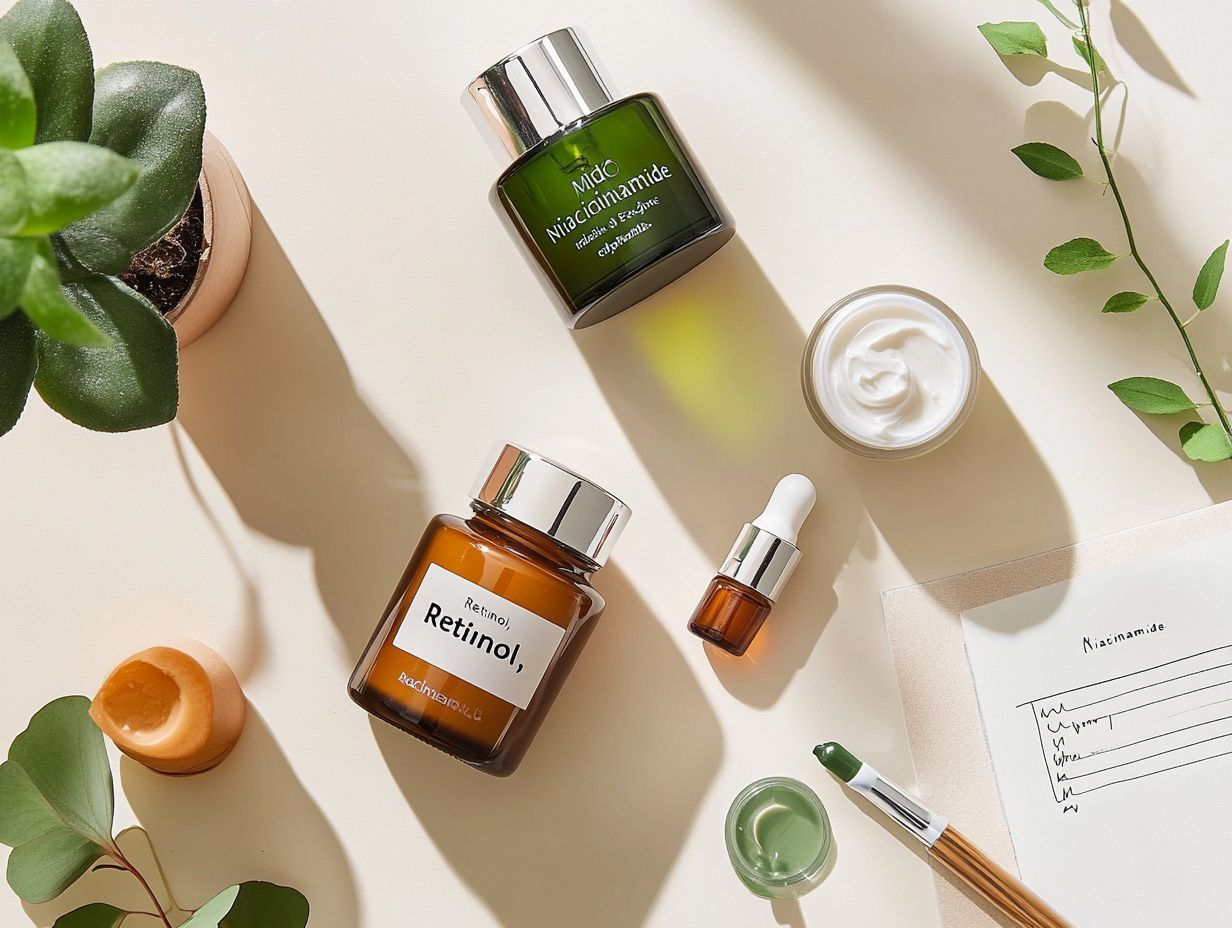
Understanding best practices for skincare layering is essential for me, as it involves recognizing the characteristics of each ingredient. For example, niacinamide enhances hydration and strengthens the skin barrier, while retinol promotes cell turnover and improves texture. This knowledge is crucial not only for achieving the desired results but also for minimizing potential skin irritation.
To optimize the effectiveness of these products, I recommend allowing adequate waiting times between applications-typically around 1 to 3 minutes. This pause ensures that each layer is fully absorbed before applying the next one, which helps prevent the ingredients from interfering with each other.
Incorporating moisturizing ingredients and ensuring proper layering skincare techniques is vital, as they help lock in hydration and create a protective barrier for the skin. Additionally, it is important to tailor skincare routines according to individual skin sensitivities and concerns, making adjustments based on how the skin reacts to various formulations.
Alternatives to Niacinamide and Retinol in the beauty industry
I recognize that there are several effective alternatives to niacinamide and retinol that can also deliver significant benefits to the skin, addressing various concerns and accommodating different skin types while considering pH levels.
For instance, ingredients such as AHAs and BHAs function as exfoliants, aiding in the removal of dead skin cells and enhancing texture, which is essential for a healthy skincare journey. Salicylic acid, in particular, proves to be highly beneficial for acne-prone skin, as it penetrates pores to help reduce breakouts, making it a cornerstone of acne treatment.
Furthermore, peptides and vitamin C play a crucial role in supporting collagen production and providing antioxidant protection, thus offering complementary benefits within a comprehensive skincare regimen alongside SPF.
Other Effective Skincare Ingredients for Facial Treatments
I find that several effective skincare ingredients can serve as alternatives to niacinamide and retinol, including AHAs, BHAs, salicylic acid, vitamin C, benzoyl peroxide, and peptides, each offering distinct benefits for skin health and cellular functions.
AHAs, or alpha hydroxy acids, are exceptional for exfoliating the outer layer of the skin, revealing a brighter complexion, often enhanced by a brightening serum. In contrast, BHAs penetrate deeper to unclog pores, making them an ideal choice for individuals with oily skin, particularly in beauty recommendations.
Salicylic acid, a specific type of BHA, is particularly effective for treating acne due to its anti-inflammatory properties, and is often featured in the skincare advice of experts like Hana Hong and Hadley King, MD from the Weill Medical College of Cornell University, New York City. Vitamin C is noteworthy for its powerful antioxidant benefits, as it helps brighten the skin and reduce signs of aging, making it a staple in beauty industry treatments. Meanwhile, peptides play a crucial role in boosting collagen production, which contributes to a firmer and more youthful appearance, essential for maintaining a moisturizing barrier against sun exposure.
When considering these alternatives, it is essential to evaluate individual skin types and concerns, as each ingredient interacts differently compared to niacinamide and retinol, which are primarily recognized for their brightening and anti-aging effects, and are frequently discussed in publications like Real Simple.


